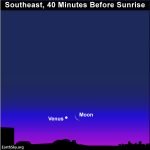
Before sunrise on March 2, 2019, look east before sunup to see the beautiful pairing of the moon and dazzling planet Venus. Good news. You don’t have to get up much before the sun to view these brilliant worlds. The moon and Venus are bright, the second-brightest and third-brightest sky objects, respectively, after the sun. In fact, people with exceptional eyesight might be able to pick up Venus near the moon after sunrise.
Help EarthSky keep going! Please donate what you can to our annual crowd-funding campaign.
If you arise before the dawn light becomes too overwhelming, two other planets can also be seen in the morning sky. Jupiter, the 4th-brightest celestial object, after the sun, moon and Venus, has risen much earlier and shines in your southern sky (or northern sky if you’re in the Southern Hemisphere). Saturn, the dimmest of the worlds now up before the sun, shines in between Jupiter and Venus. See the sky chart below.
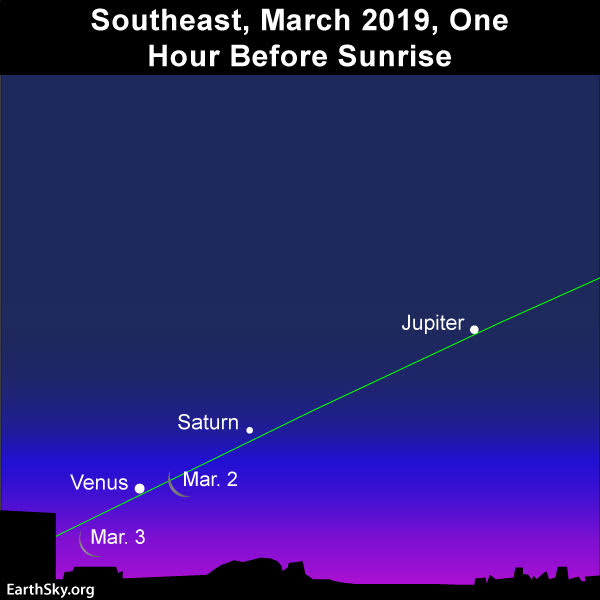
It’ll even be harder to spot the thinner, paler moon lower down in the sky before sunrise March 3, 2019.
Note on the sky chart above, which is for middle latitudes in the Northern Hemisphere, that the lunar crescent is C-shaped. The lit side of the moon points in the direction of sunrise, and the moon and planets line-up pretty much in a sideways direction. That’s because the ecliptic – the pathway of the sun, moon and planets – crosses the sky at a very shallow angle on late winter and early spring mornings.
Contrast the sky chart above to the one below for Valdivia, Chile (40 degrees south latitude). The lunar crescent is closer to U-shaped, and the planets are aligned almost vertically (Jupiter is so high up that it’s actually outside the chart). That’s because the ecliptic hits the horizon almost perpendicularly on late summer and early autumn mornings. It’s now late summer for the Southern Hemisphere.
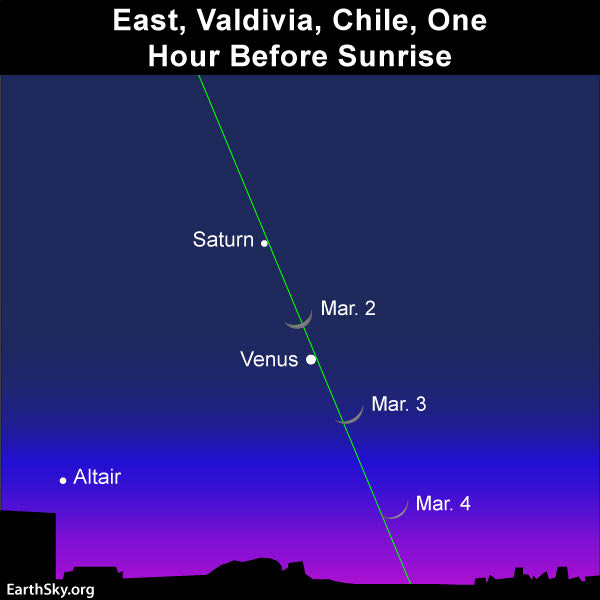
As viewed from the Southern Hemisphere, the waning crescent moon and the morning planets are found higher in the sky. Jupiter is way higher up, outside the view of the chart.
About a week from now – around March 7 or 8, 2019 – the young waxing crescent moon will make its first appearance in the evening sky. But, this time around, mid-northern latitudes will see a U-shaped evening crescent whereas the folk at Valdivia, Chile, and temperate latitudes in the Southern Hemisphere, will see a C-shaped evening crescent. That’s because the ecliptic hits the evening horizon at a steep angle in late winter and early spring, yet a shallow angle in late summer and early autumn. The charts below show the same sky from differing vantage points.
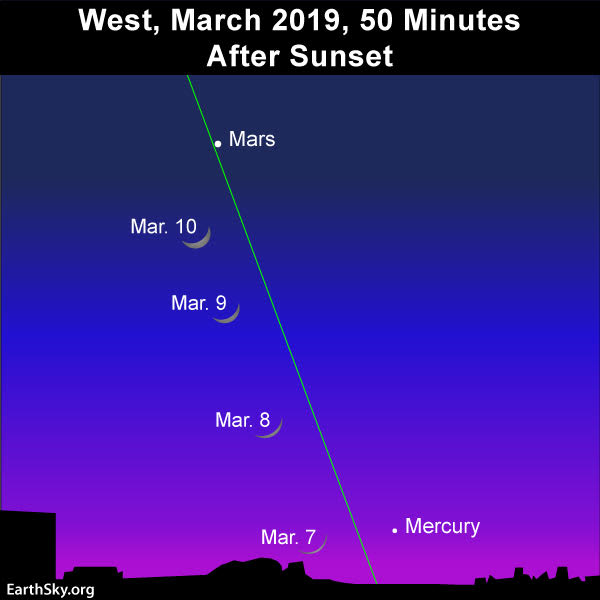
A Northern Hemisphere view of the young evening crescent with the planets Mercury and Mars from March 7-10, 2019. Read more.
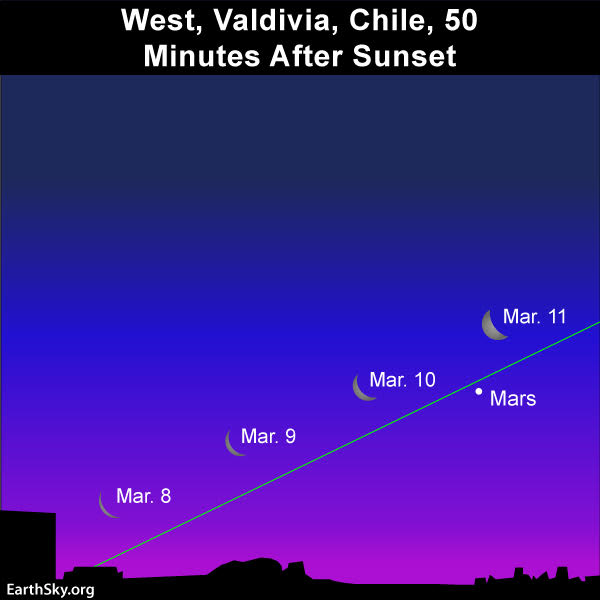
The view of the young March moon from Valdivia, Chile, South America (40 degrees south latitude). Read more.
A slender waning crescent moon that appears in the east a short while before sunrise is known as an old moon. These next few mornings you might notice the dark side of the moon softly illuminated in earthshine – twice-reflected sunlight bouncing from the Earth to the moon, and then from the moon back to Earth.
This earthshine – an ashen glow on the nighttime side of the waning crescent – is sometimes poetically described as the new moon in the old moon’s arms.
View at EarthSky Community Photos. | This is earthshine, the faint illumination on the darkened portion of a crescent moon – captured on a waxing moon, on February 7, 2019 – by Radu Anghel in Bacau, Romania. Thank you, Radu.
Bottom line: On the morning of March 2, 2019, watch for the old moon and dazzling planet Venus in the east before sunup.
from EarthSky https://ift.tt/2ILHyLb

Before sunrise on March 2, 2019, look east before sunup to see the beautiful pairing of the moon and dazzling planet Venus. Good news. You don’t have to get up much before the sun to view these brilliant worlds. The moon and Venus are bright, the second-brightest and third-brightest sky objects, respectively, after the sun. In fact, people with exceptional eyesight might be able to pick up Venus near the moon after sunrise.
Help EarthSky keep going! Please donate what you can to our annual crowd-funding campaign.
If you arise before the dawn light becomes too overwhelming, two other planets can also be seen in the morning sky. Jupiter, the 4th-brightest celestial object, after the sun, moon and Venus, has risen much earlier and shines in your southern sky (or northern sky if you’re in the Southern Hemisphere). Saturn, the dimmest of the worlds now up before the sun, shines in between Jupiter and Venus. See the sky chart below.

It’ll even be harder to spot the thinner, paler moon lower down in the sky before sunrise March 3, 2019.
Note on the sky chart above, which is for middle latitudes in the Northern Hemisphere, that the lunar crescent is C-shaped. The lit side of the moon points in the direction of sunrise, and the moon and planets line-up pretty much in a sideways direction. That’s because the ecliptic – the pathway of the sun, moon and planets – crosses the sky at a very shallow angle on late winter and early spring mornings.
Contrast the sky chart above to the one below for Valdivia, Chile (40 degrees south latitude). The lunar crescent is closer to U-shaped, and the planets are aligned almost vertically (Jupiter is so high up that it’s actually outside the chart). That’s because the ecliptic hits the horizon almost perpendicularly on late summer and early autumn mornings. It’s now late summer for the Southern Hemisphere.

As viewed from the Southern Hemisphere, the waning crescent moon and the morning planets are found higher in the sky. Jupiter is way higher up, outside the view of the chart.
About a week from now – around March 7 or 8, 2019 – the young waxing crescent moon will make its first appearance in the evening sky. But, this time around, mid-northern latitudes will see a U-shaped evening crescent whereas the folk at Valdivia, Chile, and temperate latitudes in the Southern Hemisphere, will see a C-shaped evening crescent. That’s because the ecliptic hits the evening horizon at a steep angle in late winter and early spring, yet a shallow angle in late summer and early autumn. The charts below show the same sky from differing vantage points.

A Northern Hemisphere view of the young evening crescent with the planets Mercury and Mars from March 7-10, 2019. Read more.

The view of the young March moon from Valdivia, Chile, South America (40 degrees south latitude). Read more.
A slender waning crescent moon that appears in the east a short while before sunrise is known as an old moon. These next few mornings you might notice the dark side of the moon softly illuminated in earthshine – twice-reflected sunlight bouncing from the Earth to the moon, and then from the moon back to Earth.
This earthshine – an ashen glow on the nighttime side of the waning crescent – is sometimes poetically described as the new moon in the old moon’s arms.
View at EarthSky Community Photos. | This is earthshine, the faint illumination on the darkened portion of a crescent moon – captured on a waxing moon, on February 7, 2019 – by Radu Anghel in Bacau, Romania. Thank you, Radu.
Bottom line: On the morning of March 2, 2019, watch for the old moon and dazzling planet Venus in the east before sunup.
from EarthSky https://ift.tt/2ILHyLb

Aucun commentaire:
Enregistrer un commentaire